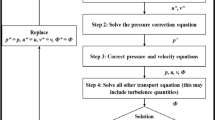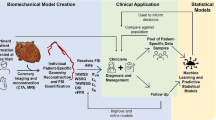Abstract
The patients with aortic aneurysm, especially aortic arch aneurysm, are prone to have aortic dissection. For investigation of the effect of aneurysm and wall stiffness on wall stress distribution, both the nonaneurysm arch model and the aneurysm arch model are constructed. The fluid structure interaction in the arch model of aorta was implemented. The results show the stresses are much higher at inflection points in aneurysm model than in nonaneurysm model, and the stresses at media in stiffened wall are higher than in unstiffened wall. The high composite stress is located at inflection points and is much higher in aneurysm model. The arch aneurysm and wall stiffening are important determinants of peak wall stress in aortic wall.
Similar content being viewed by others
References
Safi, H.J. and Estrera, A.L.,Aortic dissection, British Journal of Surgery, 91: 523–525, 2004.
Macura, K.J., Corl, F.M., Fishman, E.K. and Bluemke, D.A.,Pathogenesis in acute aortic syndromes, American Journal of Roentgenology, 181:309–316, 2003.
Mehta, R.H., Bossone, E., Evangelista, A., et al., 2004.Acute type B aortic dissection in elderly patients. Ann. Thorac. Surg., 77, 1622–1629.
Kitamura, M., Hashimoto, A., Aomi, S., Imamaki, M. and Koyanagi, H.,Medium-term results after surgery for aortic arch aneurysm with hypothermic cerebral perfusion, Eur. J. Cardiothorac. Surg., 9:697–700, 1995.
Calvet, D., Boutouyrie, P., Touze, E., Laloux, B., Mas, J.L. and Laurent, S.,Increased Stiffness of the Carotid Wall Material in Patients with Spontaneous Cervical Artery Dissection. Stroke, 35:2078–2082, 2004.
Blacher, J., Asmar, R. and Djane, S.,Aortic pulse wave velocity as a marker of cardiovascular risk in hypertensive patients, Hypertension, 33:1111–1117, 1999.
Blacher, J., London, G.M., and Safar, M.E.,Influence of age and end-stage renal disease on the stiffness of carotid wall material in hypertension, J. Hypertens., 17:237–244, 1999.
Avolio, A.P., Chen, S.G. and Wang, R.P.,Effects of ageing on changing arterial compliance and left ventricular load in a northern Chinese urban community, Circulation, 68:50–58, 1983.
Avolio, A., Jones, D. and Tafazzoli-Shadpour, M.,Quantification of alterations in structure and function of elastin in the arterial media, Hypertension, 32:170–175, 1998.
Benetos, A.,Pulse pressure and arterial stiffness in type 1 diabetic patients, Journal of Hypertension, 21:2005–2007, 2003.
Gao, F., Watanabe, M. and Matsuzawa, T.,Stress analysis in a layered aortic arch model under pulsatile blood flow, BioMedical Engineering OnLine, 5, 25, 2006.
Maxey, T.S., Serfontein, S.J., Reece, T.B., Rheuban, K.S. and Kron, I.L.,Transverse arch hypoplasia may predispose patients to aneurysm formation after patch repair of aortic coarctation, Ann. Thorac. Surg., 76(4):1090–1093, 2003.
Riley, W.A., Barnes, R.W., Evans, G.W. and Burke, G.L.,Ultrasonic Measurements of the Elastic Modulus of the Common Carotid Artery: the Atherosclerosis Risk in Communities (ARIC) Study, Stroke, 23:952–956, 1992.
Sekhri, A.R., Lees, W.R. and Adiseshiah, M.,Measurement of aortic compliance in abdominal aortic aneurysms before and after open and endoluminal repair: preliminary results, J Endovasc. Ther., 11:472–482, 2004.
Di Martino, E.S., Guadagni, G., Fumero, A., Ballerini, G., Spirito, R., Biglioli, P. and Redaelli, A.,Fluid-structure interaction within realistic three-dimensional models of the aneurysmatic aorta as a guidance to assess the risk of rupture of the aneurysm, Med. Eng. Phys. 23:647–655, 2001.
Bar-Yoseph P.Z., Mereu S., Chippada S. and Kalro V.J.,Automatic monitoring of element shape quality in 2-D and 3-D computational mesh dynamics, Computational Mechanics, 27:378–395, 2001.
Marzao, A., Luo, X.Y. and Bertram, C.D.,Three-dimensional collapse and steady flow in thick-walled flexible tubes, Journal of Fluid and Structures, 20:817–835, 2005.
Liepsch, D., Moravec, S. and Baumgart, R.,Some Flow Visualization and Laser-Doppler Velocity Measurements in A True-to-scale Elastic Model of A Human Aortic Arch—A New Model Technique, Biorheology, 29:563–580, 1992.
Perktold, K., Resch, M. and Florian, H., Pulsatile Non-Newtonian Flow Characteristics in A Three-dimensional Human Carotid Bifurcation Model, J. Biomech. Eng., 113:464–475, 1991.
Pedley, T.J.,The Fluid Mechanics of Large Blood Vessels. Cambridge University Press, 1980.
Nerem, R.M.,Vascular fluid mechanics, the arterial wall, and atherosclerosis, J. Biomech. Eng., 114(3):274–282, 1992.
Shahcheraghi N., Dwyer H.A., Cheer A.Y., Barakat A.I. and Rutaganira T.,Unsteady and three-dimensional simulation of blood flow in the human aortic arch, J. Biomech. Eng., 124:378–387, 2002.
Endo, S., Sohara, Y. and Karino, T.,Flow Patterns in Dog Aortic Arch Under A Steady Flow Condition Simulating Midsystole, Heart Vessels, 11:180–191, 1996.
Fatouraee, N. and Amini, A.A.,Recovery of flow patterns in an abdominal aortic aneurysm phantom from phase contrast MRI, Proceedings of the IEEE Workshop on Mathematical Methods in Biomedical Image Analysis. Hilton Head Island, South Carolina, 104–109, 2000.
Li, Z. and Kleinstreuer, C.,Blood flow and structure interactions in a stented abdominal aortic aneurysm model, Medical Engineering & Physics, 27(5): 369–382, 2005.
Marston, W.A., Criado, E., Baird, C.A. and Keagy, B.A.,Reduction of aneurysm pressure and wall stress after endovascular repair of abdominal aortic aneurysm in a canine model, Journal Annals of Vascular Surgery, 10(2):166–173, 1996.
Stein, P.D. and Sabbah, H.N.,Turbulent blood flow in the ascending aorta of humans with normal and diseased aortic valves, Circulation Research, 39:58–65, 1976.
Berguer R., Bull J. and Khanafer K.,Refinements in Mathematical Models to Predict Aneurysm Growth and Rupture, Annals of the New York Academy of Sciences, 1085 (1):110–116, 2006.
Moayeri, M.S. and Zendehbudi, G.R.,Effects of elastic property of the wall on flow characteristics through arterial stenoses, J. Biomech., 36 (4):525–535, 2003.
Oscuii, H.N., Shadpour, M.T. and Ghalichi, F.,Flow Characteristics in Elastic Arteries Using a Fluid-Structure Interaction Model, American Journal of Applied Sciences, 4(8):516–524, 2007.
Vorp, D.A., Raghavan, M.L. and Webster, M.W.,Mechanical Wall Stress in Abdominal Aortic Aneurysm: Influence of Diameter and Asymmetry, J. Vasc. Surg. 27:632–639, 1998.
Raghavan, M.L., Vorp, D.A., Federle, M.P., et al.,Wall Stress Distribution on Three-Dimensionally Reconstructed Models of Human Abdominal Aortic Aneurysm, J. Vasc. Surg., 31:760–769, 2000.
Sonesson, B., Hansen, F. and Lanne, T.,Abdominal aortic aneurysm: a general defect in the vasculature with focal manifestations in the abdominal aorta, J. Vasc. Surg., 26:247–254, 1997.
Tsukamoto, S., Shindo, S., Obana, M., Akiyama, K., Shiono, M. and Negishi, N.,DeBakey IIIb aortic dissection originating in a distal aortic arch aneurysm, Ann. Thorac. Cardiovasc. Surg., 9:209–211, 2003.
Green, G.R. and Kron, I.L.,Aortic Dissection, Card. Surg. Adult, 2:1095–1122, 2003.
Khan, I.A. and Nair, C.K.,Clinical, Diagnostic, and Management Perspectives of Aortic Dissection, Chest, 122:311–328, 2002.
Horsten, J.B., van Steenhoven, A.M. and van Dongen, A.A.,Linear propagation of pulsatile waves in viscoelatic tubes, J. Biomech., 22:477–484, 1989.
Giannogloulas, G., Soulis, J., Farmakis, T., Papadopoulou, S., Parcharidis, G. and Louridas, G.,A computational model to predict aortic wall stresses in patients with systolic arterial hypertension, Med. Hypotheses, 65:1191–1195, 2005.
Beller, C.J., Labrosse, M.R., Thubrikar, M.J. and Robicsek, F.,Role of aortic root motion in the pathogenesis of aortic dissection, Circulation, 109:763–769, 2004.
Okamoto, R.J., Xu, H., Kouchoukos, N.T., Moon, M.R. and Sundt, T.M. 3rd.,The influence of mechanical properties on wall stress and distensibility of the dilated ascending aorta, J. Thorac. Cardiovasc. Surg., 126(3):842–850, 2003.
Vorp, D.A., Schiro, B.J., Ehrlich, M.P., Juvonen, T.S., Ergin, M.A. and Griffith, B.P.,Effect of aneurysm on the tensile strength and biomechanical behavior of the ascending thoracic aorta, Ann. Thorac. Surg., 75(4):1210–1214, 2003.
Okamoto, R.J., Wagenseil, J.E., DeLong, W.R., Peterson, S.J., Kouchoukos, N.T., and Sundt, T.M. 3rd.,Mechanical Properties of dilated human ascending aorta, Ann. Biomed. Eng., 30(5):624–635, 2002.
Borghi, A., Wood, N.B., Mohiaddin, R.H. and Xu, X.Y.,3D geometric reconstruction of thoracic aortic aneurysms, Biomed. Eng. Online, 5, 59, 2006.
Mori, D. and Yamaguchi, T.,Computational mechanical analysis of blood flow in the human aortic arch with complex 3-D configuration — a combined effect of the torsion of the aorta and its branches, Bioengineering Conference ASME., 50: 741–742, 2001.
Kilner, P.J., Yang, G.Z., Mohiaddin, R.H., Firmin, D.N. and Longmore, D.B.,Helical and retrograde secondary flow patterns in the aortic arch studied by three-directional magnetic resonance velocity mapping, Circulation, 88: 2235–2247, 1993.
Author information
Authors and Affiliations
Corresponding author
Rights and permissions
About this article
Cite this article
Gao, F., Ohta, O. & Matsuzawa, T. Fluid-structure interaction in layered aortic arch aneurysm model: assessing the combined influence of arch aneurysm and wall stiffness. Australas. Phys. Eng. Sci. Med. 31, 32–41 (2008). https://doi.org/10.1007/BF03178451
Received:
Revised:
Issue Date:
DOI: https://doi.org/10.1007/BF03178451




